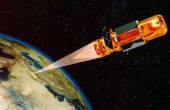On September 10, 2001, Donald Rumsfeld announced at a news conference that the Department of Defense could not account for 2.3 trillion dollars of public money. The money went somewhere, and probably not where the public would agree it should go. Maybe they spent that money on secret programs the public might not understand or appreciate, like outer-orbital laser cannons.
What was so recently science fiction has become a reality with very challenging implications. The future of warfare will be increasingly determined by our capacity to control and strike the battlefield from space. Buildings could be incinerated. Individuals, troops, and convoys could be erased. Tanks, planes, and satellites could be tracked, targeted, and destroyed. In a literal sense, there is no higher ground to take.
Some day in the not too distant future they will publicly test these weapons, and in many respects it will signify the success of their Global Dominance Project. We may yet be able to prevent the creation of this satellite weapons system, but not until more people start to recognize that it’s not science fiction anymore. It may in fact be one of the greatest threats to our liberty.
“Active measures will include battlespace control operations to guarantee the air, sea, space, and information superiority that is needed to gain the degree of control to accomplish the assigned tasks. Active measures will also include an integrated, in-depth theater air and missile defense that will exploit Service-unique capabilities to detect, identify, locate, track and deny enemy attacks on our joint forces.” 1
“The first core competency, air and space superiority, is critical in providing joint force commanders both freedom from attack as well as freedom to attack. With it, joint forces can dominate enemy operations in all dimensions – land, sea, air and space. In the 21st century, technology will make it possible to find, fix or track, and target anything that moves on the surface of the Earth.” 2
“The United States must retain superiority in space. Global intelligence collection, navigation support, meteorological forecasting, and communications rely on space-based assets. To maintain our current advantage in space even as more users develop capabilities and access, we must focus sufficient intelligence efforts on monitoring foreign use of space-based assets as well as develop the capabilities required to protect our systems and prevent hostile use of space by an adversary.” 3
“But, over the longer term, maintaining control of space will inevitably require the application of force both in space and from space, including but not limited to anti-missile defenses and defensive systems capable of protecting U.S. and allied satellites; space control cannot be sustained in any other fashion, with conventional land, sea, or airforce, or by electronic warfare. This eventuality is already recognized by official U.S. national space policy, which states that the ‘Department of Defense shall maintain a capability to execute the mission areas of space support, force enhancement, space control and force application.” 4
“Global Engagement is the combination of global surveillance of the Earth (see anything, anytime), worldwide missile defense, and the potential ability to apply force from space. GE addresses increasing ballistic and cruise missile threats, the need for force application, and the need for effective forward presence with reduced forward basing. By 2020, a second generation system for National Missile Defense is expected to be in place—with many of the weapons and sensors potentially moving into space. Surveillance and strike missions for land, sea, and air will improve using space systems.” 5
“In addition to exploiting space for their own purposes, future adversaries will also likely seek to deny U.S. forces unimpeded access to space. Space surveillance, ground-based lasers and space jamming capabilities, and proximity micro satellites are becoming increasingly available. A key objective for transformation, therefore, is not only to ensure the U.S. ability to exploit space for military purposes, but also as required to deny an adversary’s ability to do so. 6
“We must prepare for more such deployments by developing assets such as advanced remote sensing, long-range precision strike capabilities, and transformed maneuver and expeditionary forces. This broad portfolio of military capabilities must also include the ability to defend the homeland, conduct information operations, ensure U.S. access to distant theaters, and protect critical U.S. infrastructure and assets in outer space. 7
“Our adversaries are gaining access to space-based information as well as acquiring new space-based capabilities. In view of this growing threat, DOD is taking on efforts to strengthen its ability to protect and defend space-based assets, also known as ‘space control.’” 8
